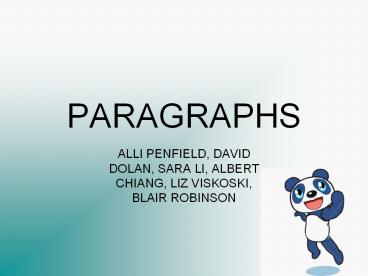PARAGRAPHS - PowerPoint PPT Presentation
1 / 22
Title:
PARAGRAPHS
Description:
... Forrest Gump Dramatic episode e.g. a description of a man making granola Anecdote e.g. a personal experience relating to the topic Transitional Paragraph ... – PowerPoint PPT presentation
Number of Views:339
Avg rating:3.0/5.0
Title: PARAGRAPHS
1
PARAGRAPHS
- ALLI PENFIELD, DAVID DOLAN, SARA LI, ALBERT
CHIANG, LIZ VISKOSKI, BLAIR ROBINSON
2
Paragraphs
Paragraphs are used to divide your subject into
manageable units of information. Combined to
show the relationship of ideas to one another and
their significance to your overall purpose. -Two
types of paragraphs Topical paragraphs -
develop a topic or idea Special paragraphs -
introduce or conclude a piece of writing or
provide a transition between major parts
3
Unity
- - In order to achieve unity in your writing, each
sentence must show a clear connection to the
topic. - - Consists of sentences that describe or reveal
characteristics of the subject.
4
Topic Sentences
- - Normally presents the main idea of the
paragraph at the beginning, though some occur in
the middle of paragraphs to have readers follow
ones train of thought. - - Introduces reader to the significance of the
entire paragraph.
5
Completeness
- - Amount of explanation needed to appropriately
address reader. - - Completeness is achieved by providing a reader
with enough information without overwhelming them.
6
Order
- Consistent order is the key to effective
paragraphs - Direction of movement
- Four directions
- General to Particular
- Particular to General
- Whole to Parts
- Question to Answer or Effect to Cause
7
General to Particular
- Paragraph starts with a general statement and
then move into specific explanations. - The paragraph helps the reader understand the
general statement
8
Particular to General
- This is the opposite of General to Particular
- Starts off with specific information and then
leads to a general conclusion
9
Whole to Parts
- Aka partitive or enumerative
- Opens with a statement which identifies the
divisions of the topic. - Paragraph goes on to define each of the parts
which were mentioned in the opening statement - Often used in argument
10
Question to Answer or Effect to Cause
- Paragraph begins with a question which the rest
of the paragraph answers - Paragraph begins with an effect and the rest of
the paragraph explains the cause.
11
Coherence
- Different from unity, completeness, and order
12
Coherence Flow
- Easier if have plan/ direction
- Non-coherent writing stems from start-stop-start
writing - Mostly caused by attention shifts (IMing,
talking, general procrastination, etc.) - Several techniques for building coherence
pronouns, contrast, repetitive structure, and
transitional markers
13
Pronoun Reference
- Connects to a prior point in the paragraph --gt
link provides unity - Reinforces subject(s) of the paragraph
Contrast
- Use if the topic sentence introduces a
compare-contrast argument - AB or A/BA/B matching sequence
- All of one side at once or every-other
alternating structure
14
Repetitive Structure
- Purposefully reusing same word(s) to make a
rhythm - Most common use is parallel structure
- Example I Have a Dream speech
Transitional Markers
- Introduces, adds, contrasts, or concludes
- For example, for instance, to illustrate
- Second, then, furthermore, in addition, also,
next - On the other hand, however, instead
- Therefore, consequentially, in other words,
finally
15
Special Paragraphs
- Paragraphs used to introduce or conclude an essay
or paragraphs used to transition from one subject
to another
16
Introductory Paragraph
- Purpose let readers know what your essay is
about, it previews the essay, and grabs the
attention of the reader - Ways to start Direct Statement, Factual
Information, Quotation, Dramatic Episode,
Anecdote
17
Introductory Paragraph (cont.)
- Direct statement
- e.g. America is getting online
- Factual information
- e.g. Ninety-seven percent of CCHS students
attend college after graduation - Quotation
- e.g. Life is like a box of chocolates, you
never know what youre gonna get -- Forrest Gump
- Dramatic episode
- e.g. a description of a man making granola
- Anecdote
- e.g. a personal experience relating to the
topic
18
Transitional Paragraph
- Purpose moving from subject to subject or from
general explanation to specific examples - Connects ideas so the essay flows
- Often quickly summarizes what has been said and
suggests what is to come
19
Concluding Paragraphs
- Purpose not necessarily to summarize the essay
but to echo the intro paragraph and globalizes
the ideas of the essay - Connects the essay to the greater world
- Some essays dont need a concluding paragraph--
dont include if it just restates what is already
said
20
Concluding Paragraphs (cont.)
- Restate and recommendation
- e.g. summarize your points and suggest a
solution to the problem - Prediction
- e.g. in an essay about global warming you
could predict what the earth will look like in
the year 2030 - Resolution
- e.g. a final climatic insight into your
experience - Quotation
- e.g. Its not what your country can do for
you its what you can do for your country ---
JFK
21
Revising Paragraphs
- Do the topical paragraphs make sense with your
topic? - Is there unity, completeness, order, and
coherence? - Does your intro hook the reader?
- Does your conclusion merely state the obvious? Or
does it leave the reader with a good impression?
22
- THE END































